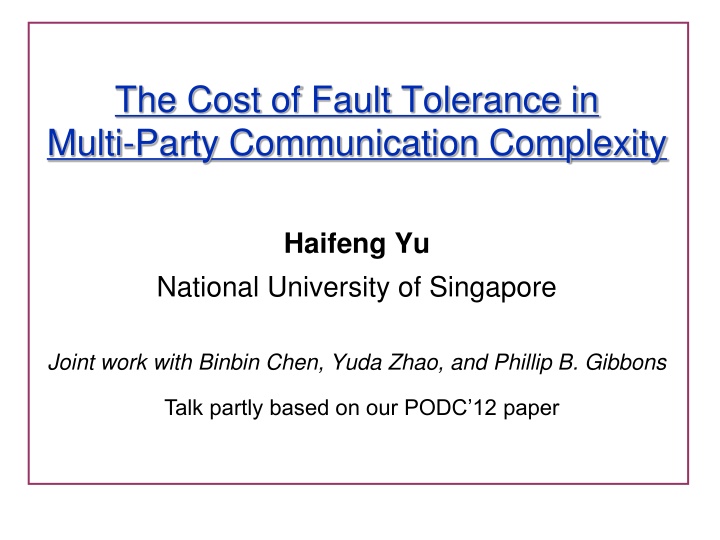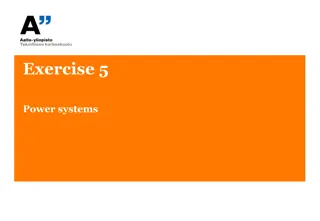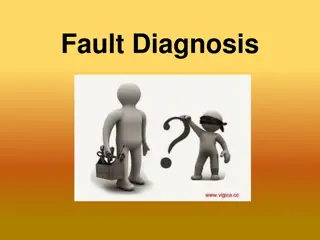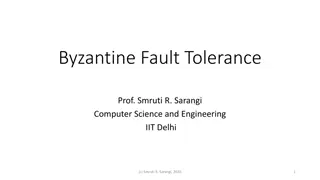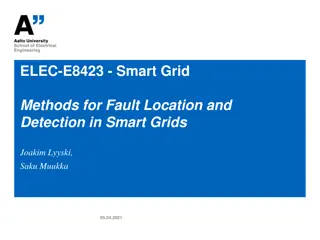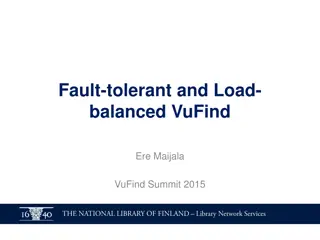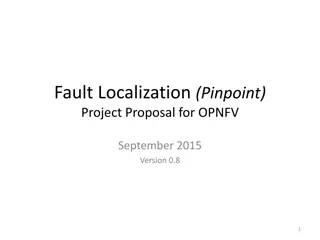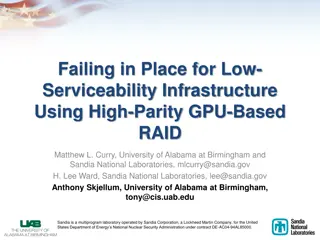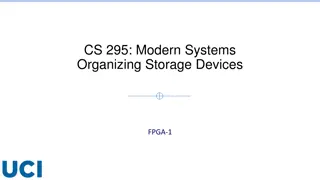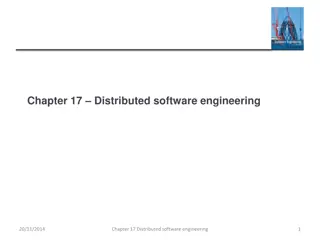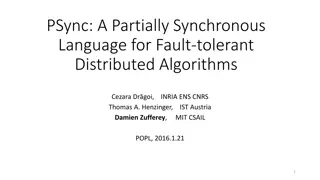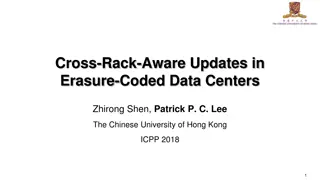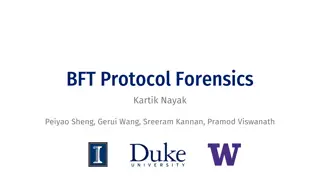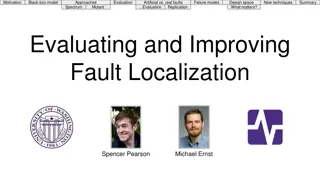The Cost of Fault Tolerance in Multi-Party Communication Complexity
This work delves into the intricate realm of multi-party communication complexity, examining the minimum communication required for fault-tolerant computations. The study explores how various functions cope with failures, presenting insights on the exponential complexity blowup needed to withstand faults for specific functions. The implications of fault-tolerant communication complexity are discussed, highlighting the need for further exploration in this domain.
Download Presentation

Please find below an Image/Link to download the presentation.
The content on the website is provided AS IS for your information and personal use only. It may not be sold, licensed, or shared on other websites without obtaining consent from the author.If you encounter any issues during the download, it is possible that the publisher has removed the file from their server.
You are allowed to download the files provided on this website for personal or commercial use, subject to the condition that they are used lawfully. All files are the property of their respective owners.
The content on the website is provided AS IS for your information and personal use only. It may not be sold, licensed, or shared on other websites without obtaining consent from the author.
E N D
Presentation Transcript
The Cost of Fault Tolerance in Multi-Party Communication Complexity Haifeng Yu National University of Singapore Joint work with Binbin Chen, Yuda Zhao, and Phillip B. Gibbons Talk partly based on our PODC 12 paper
The Central Question Multi-party communication complexity: Minimum communication (# of bits) needed to compute f() over inputs held by distributed players connected by some topology Focus is usually on lower bounds Fault-tolerant (multi-party) communication complexity: Allow player crash failures If we want to compute f in a fault-tolerant way, what will the communication complexity be? While natural, this question has never been formally posed/ studied see paper for possible reasons Haifeng Yu, National University of Singapore 2
Make the Question Meaningful Restriction 1: Some special root player never fails and only root needs to know the answer Restriction 2: Allow the computation to ignore inputs held by players that have failed or disconnected from the root Some functions (e.g., disjointness) no longer interesting Some functions (e.g. sum) still are All these restrictions make our lower bounds stronger Haifeng Yu, National University of Singapore 3
One-Sentence Summary of Our Result Our result: Exponential communication complexity blowup in order to tolerate failures, for some functions E.g, Sum, Median, etc, Other functions (e.g., Max) do not have any blowup Implications: Fault-tolerant communication complexity needs to be studied separately New topic ripe with interesting open questions Haifeng Yu, National University of Singapore 4
The Sum Function root (never fails) Each non-root node may experience crash failure N Total up to failures log N see paper for further relaxation of this assumption No messages losses Ignore collision here -- paper considers collision Synchronous timing model Wireless networks with arbitrary N-node topology, topology known to all nodes Haifeng Yu, National University of Singapore 5
The Sum Function root (never fails) 0 1 Each node has a bit, root wants to know sum 0 1 Allow randomization, allow public coins 1 1 0 1 Given a protocol for computing Sum, let ai be the number of bits sent by node i. Protocol s CC is the maximum ai across all i s, when running the protocol over the worst-case N-node topology. Sum s CC is the minimum CC, taken across all protocols CC. Haifeng Yu, National University of Singapore 6
Non-Fault-Tolerant Communication Complexity of Sum root (never fails) 0 1 1 Correctness Definition zero-error sum: 5 ( , )-approximate sum: any s where Pr[ |s 5| > 5 ] < 1 2 0 1 3 0 1 1 1 0 1 1 Well-known tree-aggregation protocol can generate zero-error sum, incurring O(logN) CC ( , ) sum, incurring O(log(1/ )) CC (for constant and ignoring loglog term) Haifeng Yu, National University of Singapore 7
Fault-Tolerant Communication Complexity of Sum root (never fails) 0 Correctness Definition zero-error sum: any r between 3 and 5 ( , )-approximate sum: any s where Pr[ |s r| > r ] < 1 0 1 1 1 0 1 disconnected Existing work mostly focus on fault-tolerant protocol designs (i.e., upper bounds) Haifeng Yu, National University of Singapore 8
Existing Fault-tolerant Protocols For Zero-Error Sum Each node floods its value and id id has logN bits Total N parallel floodings Each node sends up to NlogN bits We are not aware of any protocol with smaller CC Sharp contrast with O(logN) non-fault-tolerant CC Can we do better than NlogN ? Haifeng Yu, National University of Singapore 9
Existing Fault-tolerant Protocols for (, ) Sum [Bawa07, JCSS] [Considine04, ICDE] [Mosk-Aoyama06, PODC] [Nath04, SenSys] (Average consensus protocols usually not fault-tolerant in our sense) All these protocols use duplicate-insensitive counting E.g., each node with a value of 1 chooses an integer from an exponentially distribution, use flooding to find the max integer, and then convert back to sum Each node sends O(1/ 2) bits (after omitting log terms) (Duplicate-insensitivity is not the only way to tolerate failures ) Sharp contrast with O(log(1/ )) non-fault-tolerant CC Can we do better than O(1/ 2) ? Haifeng Yu, National University of Singapore 10
Lower Bounds on Fault-Tolerant Communication Complexity of Sum? No lower bounds have ever been obtained From communication complexity perspective, we want to focus on lower bounds Our central contribution: The first lower bounds on the fault-tolerant CC of Sum Haifeng Yu, National University of Singapore 11
Our result: Three lower bounds for zero-error Sum Communication complexity (in bits) Lower bound for fault-tolerant protocols ~ ( ) N N ~ 2 b ( ) log N Implying that the trivial flooding protocol is optimal Upper bound for non-fault-tolerant protocols ( ) ( ) log N log N ( ) 1 b 2 c 1 . 0 25 c N Time complexity = (b eccentricity) rounds Haifeng Yu, National University of Singapore 12
Our result: Three lower bounds for zero-error Sum Communication complexity (in bits) ~ ( ) N N ~ 2 b ( ) log N exponential gap exponential gap exponential gap ( ) ( ) log N log N ( ) 1 b 2 c 1 . 0 25 c N Time complexity = (b eccentricity) rounds Haifeng Yu, National University of Singapore 13
Our result: 3 lower bounds for (,)-approximate Sum Communication complexity (in bits) Lower bound for fault-tolerant protocols 1 ~ 1 b ~ 2 2 1 log Upper bound for non-fault-tolerant protocols Implying that the existing protocols based on duplicate-insensitive 1 1 techniqeus are optimal log ( ) 1 log b 2 c 1 5 . 0 c Time complexity = (b eccentricity) rounds Haifeng Yu, National University of Singapore 14
Our result: 3 lower bounds for (,)-approximate Sum Communication complexity (in bits) 1 ~ 1 b ~ 2 2 1 exponential gap log exponential gap exponential gap 1 1 log ( ) 1 log b 2 c 1 5 . 0 c Time complexity = (b eccentricity) rounds Haifeng Yu, National University of Singapore 15
Implications of Our Exponential Gap Results Sum can be reduced to/from other functions such as Median A non-trivial set of functions have exponential gap between fault-tolerant CC and non-fault-tolerant CC A non-trivial set of functions (e.g., Max) have small gap see paper All existing CC research are on non-fault-tolerant CC Our exponential gap attests that fault-tolerant CC needs to be studied separately A new topic ripe with many interesting open questions Haifeng Yu, National University of Singapore 16
Roadmap Summary of our results Our proof techniques depend on the value of b (recall Time complexity = (b eccentricity) rounds) 1 2 b c : Simple but interesting reduction from UnionSize identifies the role of failures in reduction . 0 25 5 . 0 c c 2 or c b N : Reduction from a new UnionSizeCP problem, which has a novel cycle promise . 0 25 5 . 0 c c or N b : Reduction from an interesting probing game Haifeng Yu, National University of Singapore 17
UnionSize The UnionSize two-party CC problem Alice and Bob each has some subset of an n-element universal set Want to compute the size of the union of the two sets Example: n = 4, Alice has 0011, Bob has 0101 union is 0111 and UnionSize = 3 Recent lower bounds [Chakrabarti11, STOC]on CC of UnionSize: Zero-error UnionSize: (n) ( , )-approximate UnionSize: (1/ 2) Haifeng Yu, National University of Singapore 18
Reducing from UnionSize to Sum Alice s input Bob s input 0 0 1 0 0 1 root 1 1 Alice and Bob needs to solve UnionSize by leveraging a Sum oracle protocol This talk only discusses a simplified reduction with weaker results see paper for the actual reduction Haifeng Yu, National University of Singapore 19
Reducing from UnionSize to Sum Alice s input Bob s input 0 0 0 1 0 1 0 1 1 root 1 1 1 Value of middle node of a chain = Alice s bit | Bob s bit All other nodes have value 0 Trivially have UnionSize = Sum Alice and Bob obtains Sum by simulating the execution of the Sum Oracle protocol on nodes in the topology Haifeng Yu, National University of Singapore 20
Spoiled Nodes Alice s input Bob s input 0 0 0 1 0 1 0 :spoiled for Alice 1 1 root 1 1 1 Alice cannot simulate those red nodes Value of middle node of a chain = Alice s bit | Bob s bit If Alice s bit is 0, then Alice cannot locally determine the value of the middle node Haifeng Yu, National University of Singapore 21
Spreading of Spoiled Nodes Alice s input Bob s input 0 0 0 Round 1 Round 2 Round 3 1 0 1 0 :spoiled for Alice 1 1 root 1 1 1 A spoiled node may causally affect its neighbors, causing them spoiled as well (i.e., can no longer be simulated by Alice) We need the root to remain unspoiled for Alice when the Sum protocol terminates Haifeng Yu, National University of Singapore 22
Role of Failures Alice s input Bob s input 0 0 0 Round 3 Round 4 1 0 1 0 :spoiled for Alice 1 1 root 1 1 1 In Round 3, inject failures to stop of spreading of spoiled nodes Haifeng Yu, National University of Singapore 23
Role of Alice-Bob Communication Alice s input Bob s input 0 0 0 Round 4 1 0 1 0 :spoiled for Alice 1 1 root 1 1 1 In Round 4, cannot fail -- otherwise all nodes are disconnected Instead, Bob simulates and forwards to Alice s message Such Alice-Bob communication is the CC incurred for solving UnionSize #of bits sent by in Sum protocol = # bit sent by Bob to Alice Haifeng Yu, National University of Singapore 24
Failures introduce spoiled nodes for Bob Alice s input Bob s input Round 4 Round 5 Round 7 Round 6 Round 8 0 0 0 :spoiled for Alice 1 0 1 0 1 :spoiled for Bob 1 root 1 1 1 Whether a chain has a failure depends on Alice s bit. Bob cannot determine whether there will be a failure at Round 4 Spoiled for Bob Alice simulates and forwards to Bob s message Must stop before Round 9 Restriction on time complexity Haifeng Yu, National University of Singapore 25
Key Aspects in Our Simple Reduction Alice simulates a set of nodes that change over time Goal: Properly injecting failures to allow the simulation to continue as long as possible N log Total # failures = = o(N) < any constant fraction of N If restrict to f failures, lower bound would be f / logN N Failed nodes themselves become spoiled nodes for Bob Spreading of such spoiled nodes leads to a restriction on time complexity Haifeng Yu, National University of Singapore 26
Roadmap Our proof techniques depend on the value of b (recall Time complexity = (b eccentricity) rounds) 1 2 b c : Simple but interesting reduction from the UnionSize two-party problem . 0 25 5 . 0 c c 2 or c b N : Reduction from a new UnionSizeCP problem, which has a novel cycle promise . 0 25 5 . 0 c c or N b : Reduction from an interesting probing game Haifeng Yu, National University of Singapore 27
Why UnionSizeCP? Challenge: Reduction from UnionSize does not seem to allow more than (2 eccentricity) rounds UnionSizeCP designed to allow b to grow above 2 in the reduction Enables continuous injection of new failures to hinder the spread of spoiled nodes caused by old failures But simulation still cannot last forever Haifeng Yu, National University of Singapore 28
UnionSizeCPn,q Take n = 5 and q = 4 Alice s input X = 00221 Bob s input Y = 01132 X and Y must satisfy the cycle promise (e.g., X5= 1 and Y5= 2) This promise is not ad hoc --- it can actually be derived --- see paper UnionSizeCP defined as # of i where Xi 0 or Yi 0, In our example, UnionSizeCP = 4 Yi Xi 0 1 2 3 0 1 2 3 The novel cycle promise When q = 2, UnionSizeCP degrades to UnionSize. Haifeng Yu, National University of Singapore 29
Communication Complexity of UnionSizeCP No prior results Our upper bound: O(n/q) Obtained via a simple deterministic protocol Decreases polynomially with q Our lower bound: (n/q2) and (1/( q2)) Obtained via information theoretic arguments See paper for details Haifeng Yu, National University of Singapore 30
Reduction from UnionSizeCP to Sum Given a fault-tolerant Sum protocol Alice/Bob can solve UnionSizeCP, by simulating Sum protocol on topology below with certain failure pattern root Haifeng Yu, National University of Singapore 31
Lower Bounds on Sum via Reduction from UnionSizeCP Reducing from UnionSizeCP gives us lower bounds on Sum for protocols with time complexity above (2 eccentricity) rounds Time complexity is (b eccentricity) rounds Use q= (b) in reduction Lower bound drops polynomially with 1/b See paper for the reduction and lower bounds Are there better problems to reduce from? Haifeng Yu, National University of Singapore 32
The Completeness of UnionSizeCP For oblivious reductions, we prove There are no better problems to reduce from UnionSizeCP is complete among the set of two- party problems reducible to Sum Any two-party problem that can be reduced to Sum can be reduced to UnionSizeCP See paper for Definition of oblivious reductions Proof This implies cycle promise and UnionSizeCP have a fundamental role Haifeng Yu, National University of Singapore 33
Conclusions If we want to compute f in a fault-tolerant way, what will the communication complexity be? As first effort on fault-tolerant CC, our central contribution is the first lower bounds on the fault-tolerant CC of Sum Exponential gap from non-fault-tolerant CC Answering the open question on the optimality of some existing protocols as well Some of the key novel aspects in our proof: Formalizing the role of failure Cycle promise and UnionSizeCP to deal with some key challenges in reduction The reduction from the probing game Haifeng Yu, National University of Singapore 34
Future Work Our exponential gap attests Impact of failures on CC is large Fault-tolerant CC needs to be studied separately from existing research on non-fault-tolerant CC A new topic ripe with many interesting open questions Extending our lower bounds to other topologies? Improving the degrees of the polynomials in our lower bounds? Early stopping protocols? Characterize the set of functions with exponential gaps? Haifeng Yu, National University of Singapore 35
